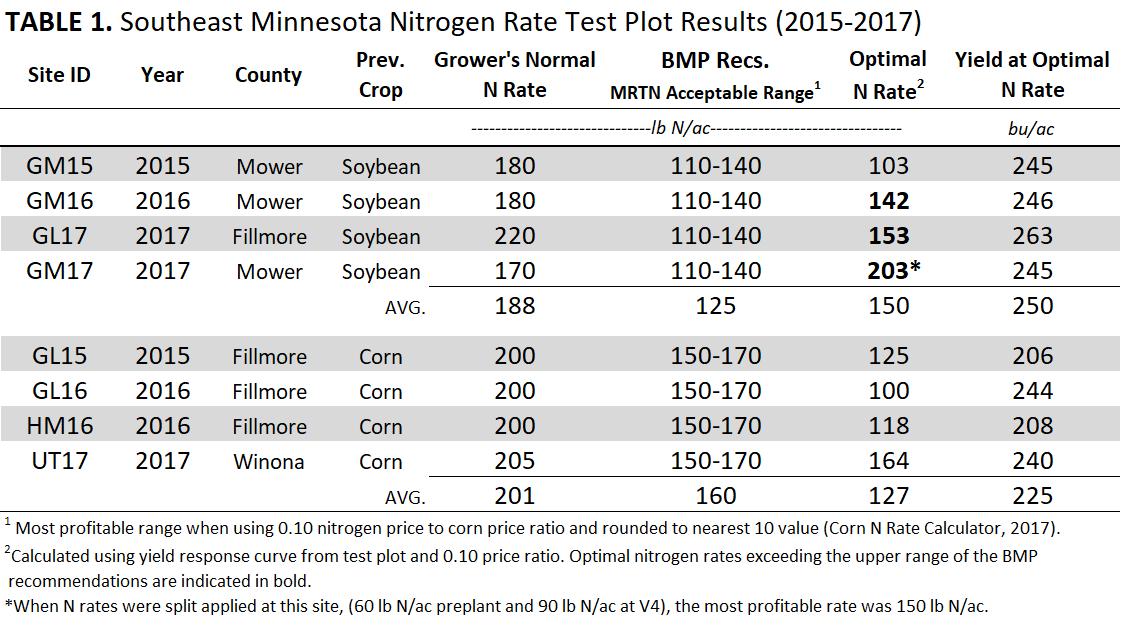Kevin Kuehner – Root River Field to Stream Partnership – Minnesota Department of Agriculture
Jeff Vetsch – University of Minnesota Southern Research and Outreach Center
The Maximum Return To Nitrogen (MRTN) is the nitrogen (N) rate that optimizes net profit. Applying rates near the MRTN can reduce risk of nitrate-nitrogen leaching to groundwater and surface water and is a recommended Best Management Practice (BMP) when fertilizing corn in Minnesota. MRTN rates are derived from over 160 Univeristy N rate response trials conducted over a variety of years and locations across the state. Most N rate response trials in the MRTN database have been conducted in southern Minnesota. Less than 20% of these studies have been conducted in southeast counties, and most are older than ten years. Farmers have observed historic increases in yield potential in the past several years with proven field averages over 240 bu/ac. Legitimate questions often arise whether BMP recommended rates, which are based on MRTN reponse trials, are adequate for today’s high yielding corn hybrids, farming systems and soil types in southeast Minnesota.
For these reasons, farmers and their advisors have requested additional studies to help improve confidence in nitrogen rate BMP recommendations. Furthermore, split applying nitrogen has gained popularity in recent years, but there are questions about how much in-season N to apply and how often split applications outperform preplant applications. In collaboration with Jeff Vetsch of the University of Minnesota and funding from MN Dept. of Agriculture’s Clean Water Fund program, eight research-grade field studies were conducted over a three-year period to evaluate the relationship between corn yield, nitrogen rate and timing in southeast Minnesota.
Table 1 summarizes results across eight sites from the period 2015-2017. The growers’ normal N fertilizer rate ranged from 170 lb N/ac to 220 lb N/ac for corn following soybean (C/S) and 200 lb N/ac to 205 lb N/ac for corn following corn (C/C). Total N rates included credits from incidental N sources such as MAP/DAP/AMS and starter fertilizer. The N rate recommendation when using the high end of the acceptable MRTN1 range was to apply 140 lb N/ac for C/S and 170 lb N/ac for C/C rotations. The maximum N rate guidance is to apply no more than 160 lb N/ac for C/S and 200 lb N/ac for C/C. (Corn N Rate Calculator V.1.9, 2017, http://cnrc.agron.iastate.edu/).

Results from this study found the optimal N rate ranged from 103 to 203 lb N/ac for C/S and 100 to 164 lb N/ac for C/C. When comparing test plot optimal N results to the upper range of the BMP rate recommendations, 5 out of 8 sites (63%) maximized yield and economics. Surprisingly, the highest N rate requirements were all corn following soybean sites. At sites GM16 and GL17, the optimal N rate was greater than the recommended BMP rate by 2 lb N/ac and 13 lb N/ac respectively. It’s predicted that BMP rates would have resulted in a marginal yield reduction of just 0.2 bu/ac and 2.0 bu/ac. The largest difference between the test plot rate and BMP rate, 63 lb N/ac, occurred at site GM17. The increased yield response to N at this site was likely attributed to leaching of fall-applied N credits and denitrification loss from compaction. It should be noted that when nitrogen was split applied at this site, the economically optimal nitrogen rate was 150 lb N/ac. With the exception of the 2017 Mower county site, all sites had optimal N rates below the maximum BMP rate. Overall, results from these high yielding corn plots showed that in most cases, BMP N rates were the most profitable. Additional on-farm studies are planned and on-going. These will enhance the MRTN database in the southeast corner of the state. To learn more about on-farm nutrient trials visit http://www.mda.state.mn.us/protecting/cleanwaterfund/onfarmprojects/nmi.
- New Life for Old Flood Structure - October 30, 2018
- Dialing in profitable nitrogen rate and timing practices - October 10, 2018
- Testing Nitrogen Rate BMP Recommendations - September 27, 2018